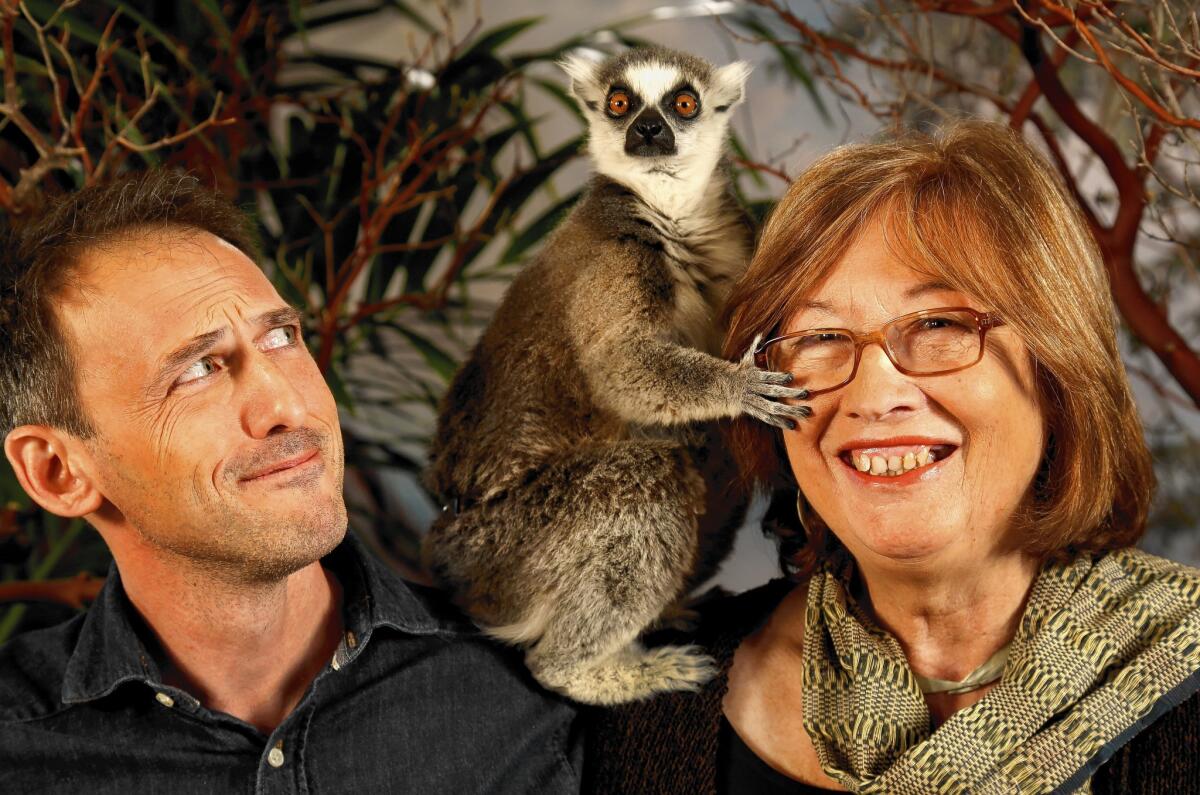‘Island of Lemurs: Madagascar’ goes beyond the cute and cuddly

Who knew lemurs were zen masters?
The primates, whose ancestors came to Madagascar some 60 million years ago, love to play. They also enjoy a good siesta on a handy branch, and when they are happy, they emit a cute little noise akin to a piglet’s snort.
They also take press junkets in stride. Last week at the Ritz-Carlton Hotel in downtown Los Angeles, Felix, a 10-year-old ring-tailed lemur, and Taj, a 7-year-old brown lemur, were chilling with their handlers, demonstrating a “don’t worry, be happy” attitude as cameras flashed all around.
Like just about anyone garnering that much attention in Los Angeles, the lemurs were in town to promote a new movie — the Imax 3-D documentary “Island of Lemurs: Madagascar,” narrated by, who else? Morgan Freeman. The film opens Friday at the California Science Center theater.
Felix and Taj watched quietly as photographers, lighting technicians, reporters and publicists swirled around them setting up for their photo op. Taj kissed his handler’s face while Felix enjoyed a snack, snorted with satisfaction and was beyond adorable.
“I think we love lemurs because they take life in a very kind of relaxed, easy way,” said primatologist Patricia C. Wright, a leading authority on lemurs and the smaller-eyed costar of the documentary.
Thanks to her efforts, the Ranomafana National Park in Madagascar opened in 1991 to protect the animals. It has become a popular eco-tourist attraction, which has brought money into the nearby village and employs many locals at its state-of-the-art research center.
“If you are watching monkeys, you will see the young ones playing but adults don’t,” said Wright. “But when you are watching lemurs, the whole family is playing and wrestling. We primatologists get to watch them. It’s great fun.”
And so is the fact that unlike most primates, all breeds of lemurs are female dominant. “I love that,” said Wright, adding that the top females don’t strut like dominant baboon and chimp males. “When someone is sitting in the place where they shouldn’t be sitting they come in with a quick, ‘Get out, I am the boss.’ They don’t need to show it.”
PHOTOS: Box office top 10 of 2013
The film introduces us to many of the lemurs that live in the remote island in the Indian Ocean, including the tiny, sharp-toothed and feisty mouse lemur; the dancing, slender Sifakas; and the Indri, who have never survived in captivity and who communicate in the mornings with a loud wail. The documentary captures for the first time a newborn Indri on film.
While their lives sound idyllic, lemurs are endangered. Some 90% of the forests on Madagascar have been destroyed — mainly by fires — and all of the giant lemurs (one breed was the size of a gorilla) are extinct. Some three-quarters of the lemurs living on the island are at risk.
“Some are critically endangered and some are threatened,” said Wright. “That’s a lot of lemurs that we have to save.”
Writer-producer Drew Fellman and director-photographer David Douglas had long wanted to make an Imax documentary set in Madagascar. But they thought it was a pipe dream.
“It’s the kind of place where the chasm between wanting to do something and being able to do something is so huge because it’s such a crazy place,” said Fellman.
PHOTOS: Behind the scenes of movies and TV
While Fellman and Douglas were making the 2011 Imax documentary “Born to Be Wild: 3D,” Fellman met Wright at a dinner given in her honor.
“Pat is very savvy and thought for years that [Imax] should do a movie on Madagascar. We started talking about it,” said Fellman.
After “Born to Be Wild” was completed, Wright invited the two to the country. “We went about a month and traveled around with her and thought there is no way to do this,” said Fellman. “The road system gets completely washed away. The animals are in often dark forests and there are so few of certain species. We would get there and they would be gone.”
And once they did find them, they had problems getting up close and personal.
But the production was able to use a 40-pound digital Imax 3-D camera, which they could transport in backpacks to remote areas. The traditional IMAX camera weighs 350 pounds.
“One of the big challenges over the year putting the movie together was finding the individual groups of lemurs who could tolerate us,” Fellman said. “Lemurs have their little territories.”
PHOTOS: Billion-dollar movie club
Wright didn’t set out to be a lemur conservationist. She had traveled to the country in 1986 to study the very rare Greater Bamboo lemur in the Ranomafana forests. While she was there, she was alarmed at the deforestation taking place.
“So I went to the capital and talked to the minister of water and forest and said you need to protect these animals,” she said. “He said that’s a great idea, but it takes money and we are a very poor country. If you get the money we will help you [protect] the forest.”
So Wright began to write grants for money to acquire the forest land and traveled to villages around the border of the forest to explain her plan and inform them the forest would be off-limits for hunting.
But she also discussed a trade-off for the loss of the hunting land. “They wanted healthcare, schools, help for their farms to be more productive and they wanted a soccer ball,” Wright said.
“They got the soccer ball first. But I can say we are working in 50 schools and have a remote healthcare team that goes to visit the most remote villages.”
More to Read
Only good movies
Get the Indie Focus newsletter, Mark Olsen's weekly guide to the world of cinema.
You may occasionally receive promotional content from the Los Angeles Times.







